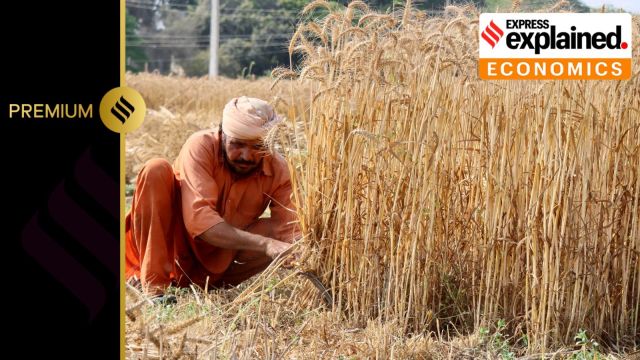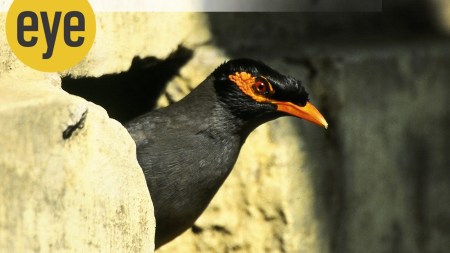- India
- International
How Punjab and Haryana remain key to national food security
The two states that are still to vote in the Lok Sabha polls have played saviour this year, amid El Niño and 16-year-low wheat stocks in government godowns.
 A farmer in Ludhiana, Punjab harvesting his wheat crop. (Express Photo by Gurmeet Singh/File)
A farmer in Ludhiana, Punjab harvesting his wheat crop. (Express Photo by Gurmeet Singh/File)An El Niño-induced agricultural output decline has underscored, yet again, the importance of Punjab and Haryana to India’s food security.
The two breadbasket states, whose farmers led the protests against the Bharatiya Janata Party-led government’s now-repealed three agricultural reform laws during 2020-21, have together accounted for 75.5% of the total wheat procured for the Central foodgrain pool in the current marketing season.
Government agencies have so far bought about 25.5 million tonnes (mt) of the 2023-24 winter-sown crop harvested from late-March. Out of that, 12.2 mt has come from Punjab and over 7 mt from Haryana. The 75.5% combined share of the two states, which are still to vote in the ongoing Lok Sabha elections, has been the highest since the 75.8% of 2015-16.
Wheat lynchpins
Till the mid-2000s, Punjab and Haryana contributed 90% or more of the wheat for feeding the public distribution system (PDS) and other government programmes.
With the Green Revolution (the cultivation of high-yielding varieties) spreading to other states, and their governments also establishing infrastructure for buying grain at minimum support prices (MSP) from farmers, the ratio dipped to roughly 65% by the early 2010s.

| TABLE 1: Wheat Procurement for Central Pool (lakh tonnes) | |||||
| 2019-20 | 2020-21 | 2021-22 | 2022-23 | 2023-24 | |
| Punjab | 127.14 | 132.22 | 96.45 | 121.17 | 122.31 |
| Haryana | 74.00 | 84.93 | 41.86 | 63.17 | 70.32 |
| MP | 129.42 | 128.16 | 46.04 | 70.97 | 45.66 |
| UP | 35.77 | 56.41 | 3.36 | 2.20 | 8.47 |
| Rajasthan | 22.25 | 23.40 | 0.10 | 4.38 | 8.35 |
| TOTAL* | 389.93 | 433.44 | 187.92 | 262.02 | 255.24 |
| *Includes other states; Figures are for Crop Year (July-June) 2023-24, till May 15.
Source: Department of Food and Public Distribution. |
|||||
In 2019-20 and 2020-21, which were bumper production years, not only did total wheat procurement hit record 39-43.3 mt levels, the share of Punjab and Haryana in that fell to just over 50%. Madhya Pradesh (MP) even briefly emerged as the country’s No. 1 wheat procurer in 2019-20, overtaking Punjab (see Table 1).
This has all changed in the last three years, which have seen production setbacks from climate shocks. These took the form of an unseasonal temperature surge in March 2022 and heavy rain in March 2023, both times during the final grain formation and filling stage of the crop.
In 2023-24, it was not the “Ides of March”, but an unusually warm November-December that has impacted wheat yields, particularly in central India. The winter’s delayed arrival this time, attributed to El Niño, resulted in premature initiation of flowering and cutting short of the crop’s vegetative growth (of roots, stems and leaves) phase. The effect was felt most in MP, Gujarat, Maharashtra and many parts of Rajasthan, where sowing happens early — from the last week of October to the first week of November.
Not surprisingly, wheat procurement from MP has plunged from 12.8-12.9 mt in 2019-20 and 2020-21 to hardly 4.6 mt this time. UP and Rajasthan, too, have posted steep drops from their 2020-21 highs. Punjab and Haryana have weathered the climate shocks better, because of longer winters and farmers there sowing mainly from early to mid-November. Uttar Pradesh (UP) and Bihar, where sowing extends till mid-December, have also reported good production due to near-normal temperatures this March. But much of the produce from those states has been purchased by private traders and millers paying more than the Centre’s MSP of 2,275 per quintal.
Punjab and Haryana have played saviour at a time when wheat stocks in government godowns, at 7.502 mt on April 1, were the lowest since the 5.803 mt on the same date of 2008. The stocks were also only a shade above the minimum operational-cum-strategic reserve of 7.46 mt necessary at the start of the marketing season.
The rice situation
In rice, government procurement was traditionally concentrated in Punjab and Haryana, plus the Godavari-Krishna and Kaveri delta regions of Andhra Pradesh (AP) and Tamil Nadu (TN).
Like with wheat, there has been a diversification here as well, with new states — especially Telangana, Chhattisgarh, Odisha and even UP — becoming major contributors to the Central pool (Table 2). In the process, the combined share of Punjab and Haryana in total rice procurement has fallen from 43-44% in the early 2000s to an average of 28.8% in the four years ended 2022-23.
| TABLE 2: Rice Procurement for Central Pool (lakh tonnes) | |||||
| 2019-20 | 2020-21 | 2021-22 | 2022-23 | 2023-24 | |
| Punjab | 108.76 | 135.89 | 125.48 | 122.01 | 124.14 |
| Haryana | 43.07 | 37.89 | 37.06 | 39.77 | 39.42 |
| Telangana | 74.54 | 94.53 | 73.94 | 88.35 | 43.87 |
| AP | 55.33 | 56.66 | 44.61 | 27.55 | 18.82 |
| Chhattisgarh | 50.53 | 47.62 | 61.65 | 58.65 | 97.10 |
| Odisha | 47.98 | 52.58 | 48.31 | 53.83 | 39.45 |
| UP | 37.90 | 44.78 | 43.91 | 43.89 | 36.05 |
| MP | 17.40 | 24.97 | 30.70 | 31.02 | 28.23 |
| Bihar | 13.41 | 23.84 | 30.09 | 28.17 | 20.78 |
| Tamil Nadu | 22.04 | 30.53 | 18.76 | 23.01 | 18.30 |
| W Bengal | 18.38 | 18.90 | 24.01 | 21.82 | 12.64 |
| TOTAL* | 518.26 | 601.71 | 575.88 | 568.66 | 497.24 |
|
*Includes other states; Figures are for Crop Year (July-June) 2023-24, till May 15. Source: Department of Food and Public Distribution. |
|||||
But the current crop year has again witnessed an increase in that ratio to around 32.9% (some procurement is still left in Telangana, AP and TN). Assured access to irrigation has meant that Punjab and Haryana farmers have taken no production hit from last year’s patchy monsoon, courtesy of El Niño. This isn’t the case with states such as Telangana, where farmers planted less area under rabi (winter-spring) paddy and also struggled to irrigate their crop owing to depleted groundwater levels.
Policy implications
Under the National Food Security Act (NFSA) passed by the previous Congress-led United Progressive Alliance government, some 813.5 million persons are entitled to receive 5 kg of wheat or rice per month through the PDS at highly subsidised prices. The current government has, since January 2023, been providing this grain to all NFSA beneficiaries free of cost.
It is unlikely that any government would dispense with the above scheme, even post the elections. The Congress, if anything, has promised to double the monthly ration quota to 10 kg for “poor” persons.
The NFSA in its present form, along with other welfare schemes (midday meals for school children, allocations for anganwadi care centres, etc) and open market sale operations (to cool down prices in inflationary episodes), would require 60-65 mt of grain to be annually procured by state agencies.
In most years, that requirement is more than comfortably covered. In 2020-21, total rice and wheat procurement crossed 103.5 mt. It is in the rare bad monsoon or climate shock year that Punjab and Haryana prove their worth.
Given their average per hectare wheat and paddy yields of 4.8 tonnes and 6.5 tonnes respectively – way above the corresponding all-India levels of 3.5 tonnes and 4.1 tonnes – the two states will continue to matter for national food security even with some desirable acreage shifts to other crops.
More Explained
EXPRESS OPINION
Jun 07: Latest News
- 01
- 02
- 03
- 04
- 05







































